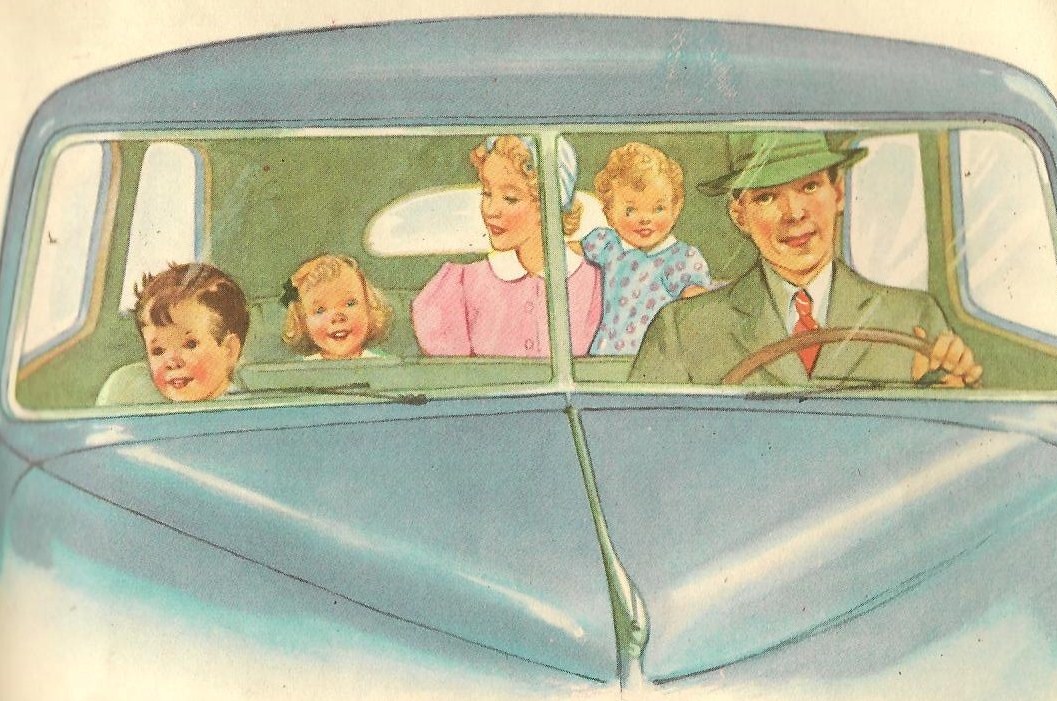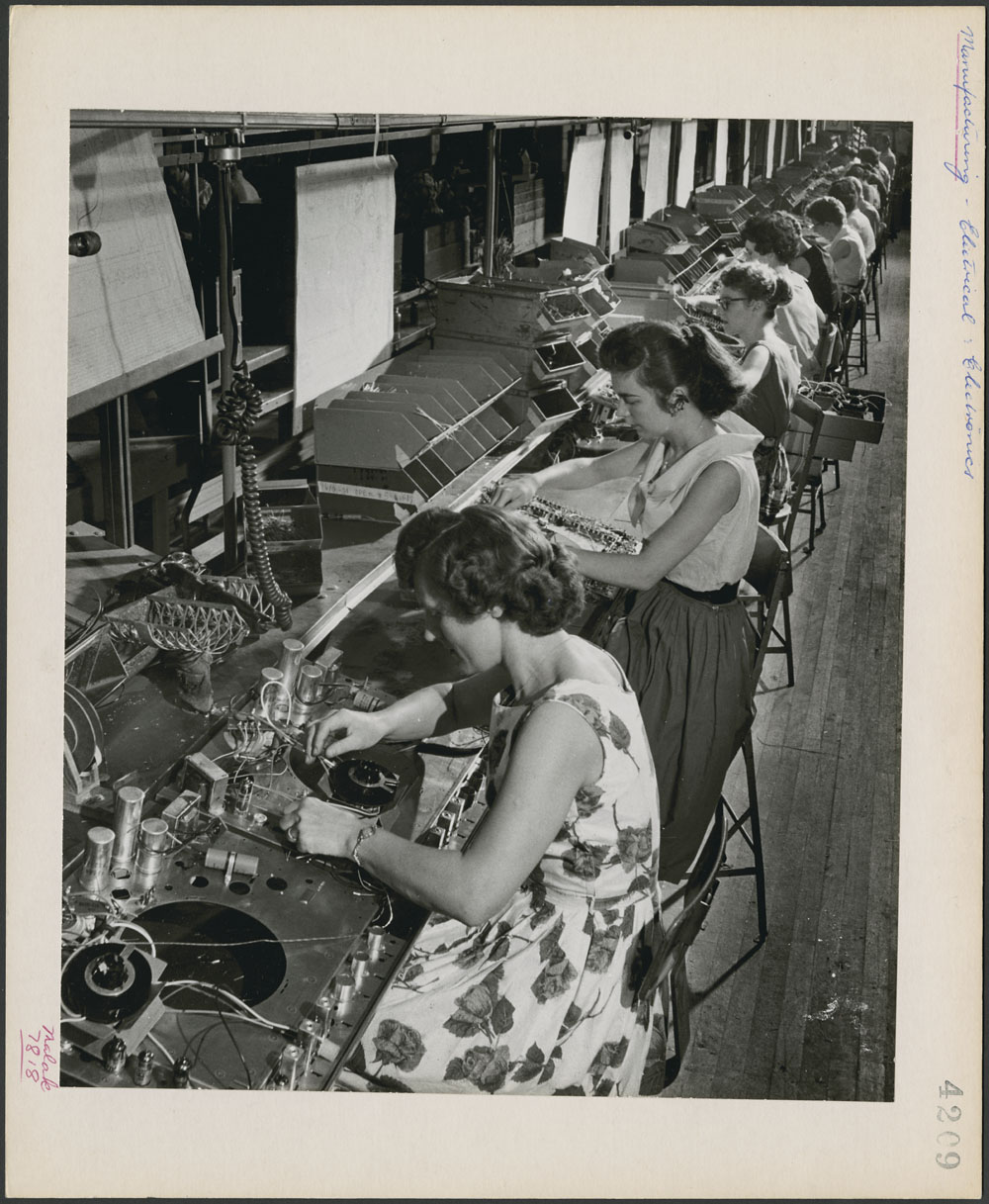Chapter 10. This is the Modern World
10.7 Gendered Roles after the Wars
Robert Rutherdale, Department of Philosophy & History, Algoma University

Gendered roles in modern Canada have passed through a period of significant change since the interwar period, especially during the 1960s. As the work of historians Veronica Strong-Boag, Mary Louise Adams, Magda Fahrni, Elise Chenier, and others illustrate, the politics of home life and gendered family regimes was dominated by a complex set of forces following demobilization in 1945-46 and into the late 1950s. Housing shortages were experienced in many parts of Canada; the peacetime restoration of domestic goods production and consumption took a decade longer in Canada than in the United States. But the desire to impose, immediately after the war, a regime of normalization, of bread-winning fathers and homemaking mothers, persisted throughout the 1950s. It was driven in part by a new family formation manifest in the baby boom between 1939 and the late 1950s. Nancy Christie and Michael Gauvreau have described this as an “interregnum period,” an extended era of post-war adjustment that lasted to the mid-1950s.[1] Historians situate changes in gendered roles and demographic patterns in the context of shifting historical forces which shaped the masculine and feminine lives of men and women and their “baby boomer” children.
For the parental generation, the dark shadows of the Great Depression and the devastation of the war years motivated the search for security — for jobs, for homes, and for a restoration of feminine domesticity supported by masculine providers — and a nationwide drive towards a better life. This was especially true for many newcomers from war-torn Europe. Such hopes, however, were based on older models of gender relations arising in the era of industrialization, some of which were already dated and challenged in the period from 1914-39. The re-mapping of gender roles as Nazism was defeated and the Cold War loomed can thus be approached as a generational as well as a gendered social historical script.
The societal urge for post-war normalization and security in Canada led many towards a search for “home” as both a public-realm cultural ideal and a private-life aspiration. Explanations for origins of the baby boom itself invariably point to a postwar-gendered and generational search for security through domesticity. The gendered family regime of mothers, fathers, and children in the 1950s thus had deep historical roots yet was shaped by a quest for normalization in its context as a postwar measure. Security through normalized gendered roles was a classed (middle) and ethnically specific (white) ideal found and promoted in television advertisements and many sitcoms of the era. It was also a cultural backdrop to the public discourse that often cut across class and ethnic differences. Imposed from above through state policies and embraced from below by many Canadians, gender roles were shaped in the 1950s and early 1960s by conformity to a nostalgic sense of the past — one that was open to challenge.
Early postwar patterns in gender roles were marked by patriarchal norms. This was especially true as a new generation of fathers and mothers began to form their own families in search of what both American and Canadian journalists, writing for the middle classes, referred to as the “good life.” As I have suggested elsewhere, some wives balked at the patriarchal power (sometimes called “hegemonic masculinity[2]” by theorists today) it imposed, but few fathers did. Postwar family life was, as Strong-Boag puts it, an “ambivalent” experiment: many wives, mothers, and homemakers who reached maturity at this time (marriage ages were comparatively younger in the 1950s) did not look back on their home dreams with bitterness, but many other women did.[3]
Men’s experiences of postwar domesticity were not without problems. Notions of “masculinity in crisis”— modern men facing a challenge to their identities as men, to cite a prominent example, had been a perennial concern across many decades — though each era, since the 19th century, generated its own mythologies about how men suffer in the modern age. In the 1950s, mid-century modern men seemed to face three crises in parables of woe that found considerable space in publications, not only in popular magazines like Maclean’s and Chatelaine, but also in some of the leading sociological publications of the day, most notably Crestwood Heights: A Study of the Culture of Suburban Life (1956). A particular triad of social forces was seen as standing against the modern man as a self-disciplined, autonomous, inner-directed, assertive being: modern bureaucracies and the modern factory system; family togetherness, which prescribed a new dictate for fathers — play with your children as if you were, almost, one of them; and, possibly worst of all, moms as matriarchal menaces, who exerted too much pressure on sons — some of whom, it was feared, would become homosexual as a result. This last challenge to manhood was, of course, also a critique of womanhood; a mixing of messages endorsed the maternal housewife while condemning her at the same time.
With respect to lived experience, these cultural myths and storylines reflected little in terms of the enduring inequalities in gendered roles in the private and public spheres. Following the immediate postwar forced exodus of most women in non-traditional jobs, there was a slow and then accelerating return to the workforce by married women. By the early 1960s, women comprised one-third of the paid workforce. Full-time earnings, however, stood at only 59% of men’s for the same labour categories and at just 54% for part-time female workers. Despite the challenges to their masculinity that most men were supposed to be facing, work-time studies of women’s labour in the home as homemakers revealed an even more gender-skewed expectation that women were responsible — as an essential characteristic of their gendered role — for most infant child care and most housework.

What stands out in histories of the postwar period, at least to the rise of the sexual revolution in the late 1960s, was the equation of heterosexuality with what the state and society considered normal gender relations. Deviance in this respect is considered in Section 12.7.
Connections between sexuality and gender roles are complex. They continue to be debated by historians today. Gender roles, if approached as shifting social and cultural responses to sexual differences, consistently demonstrate historical categories and powers that connect the body to boundaries of class, age, and ethnicity. In 2014, the Organization for Economic Cooperation and Development (OECD) released its Better Life Index, indicating that Canadian women spend, on average, some 254 minutes per day cooking, cleaning, and caring for children, compared to 160 minutes for men performing the same tasks. These 21st-century trends have deep historical roots in gender roles defined more by patriarchy than by equal partnership. Histories of the struggle for women’s rights and the gendering of experience are one means for challenging those persistent norms. Now more than ever before, these confrontations with histories of inequality become apparent in legislation and official policies that embrace still-wider notions of gender and identity. In this sense, the translation of historic roles and restrictions into postmodern constructions of gender roles in Canada is part of a continuity of transformation, and not only a landscape of change.
In the decade of the first postwar generation, as Bryan Palmer observes, the turbulent sixties brought with it a “generation gap” in social mores and gender roles between young women and men in Canada, as elsewhere — but this came later, as the postwar generation of baby boomers reached maturity in the late 1960s.[4]
Key Points
- Normalizing gender roles in the form of bread-winner fathers and homemaker mothers was part of the postwar project of rebuilding Canadian society and its economy.
- This pursuit of a new gendered ‘normal’ has been interpreted as part of a search for security and relative prosperity on the part of a generation directly impacted by the Depression and WWII. Normalcy may have been imposed from the top but it was embraced from below as well.
- Features of these gendered roles include a strengthening of patriarchal authority and privilege for men in heterosexual circumstances.
- By the early 1960s, women were returning to the workforce in significant numbers, despite wage and other barriers to their participation.
- Historical studies of gender roles and sexuality indicate a complex pattern of ongoing transformation and show us that traditional roles are, themselves, transitory.
Media Attributions
- On the Road © Miriam Story Hurford is licensed under a CC BY (Attribution) license
- An assembly line of women working at the Canadian Marconi Company, Montreal © Canada Dept. of Manpower and Immigration, Library and Archives Canada (MIKAN no. 4369810) is licensed under a Public Domain license
- Nancy Christie and Michael Gauvreau, eds., Cultures of Citizenship in Post-War Canada, 1940-1955 (Montreal & Kingston: McGill-Queen’s University Press, 2003). ↵
- On this topic, see R.W. Connell and James W. Messerschmidt. "Hegemonic Masculinity: Rethinking the Concept". Gender and Society, 19, 6 (2005): 829-859. ↵
- Veronica Strong-Boag, “Home Dreams: Canadian Women and the Suburban Experience, 1945-60”,” Canadian Historical Review 72:4 (December 1991): 24-34. ↵
- Bryan Palmer, Canada’s 1960s: The Ironies of Identity in a Rebellious Era (Toronto: University of Toronto Press, 2009). ↵
A complex of views arising in the late modernist period that questioned the era's certainties, invited a skeptical analysis of conventions, focussed on pluralism rather than unity (both politically and artistically); contains anti-modernist elements (such as the return to craft and artisanal production) but is not otherwise anti-modern in the way that the original opponents to modernism were.

